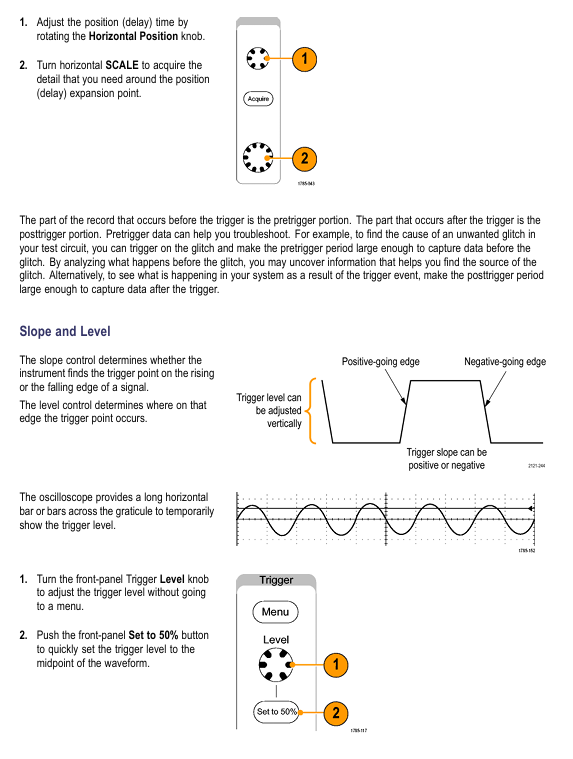Tektronix MSO4000/DPO4000 series digital fluorescence oscilloscope
Connection: CH1 is connected to the TX line, CH2 is connected to the RX line, press 【 B1 】 → 【 Bus 】 → 【 RS-232 】;
Set parameters: baud rate 9600, data bit 8, parity None, stop bit 1;
Trigger: Press 【 Trigger Menu 】→【 Type 】→【 Bus 】→【 Trigger On 】→【 Tx Data 】, set the trigger data to 0x55;
Analysis: Press 【 Search 】 → 【 Bus 】 → 【 Tx Data 】, mark all 0x55 frames, and use Wave Inspector to view the timing of abnormal frames;
Case 2: Relay arc capture
Parameter setting: CH1 is connected to both ends of the relay, Vertical scale 100V/div,Horizontal scale 10μs/div;
Trigger: Press 【 Trigger Menu 】→【 Type 】→【 Edge 】→【 Slope 】→【 Rising 】, set the trigger level to 50V;
Capture: Press [Single] to trigger when the relay is disconnected, observe the peak generated by the arc (amplitude>200V);
Optimization: Zoom in on the peak area (Zoom x 10) and measure the peak width with the cursor (approximately 50ns).
Appendix and Support
1. Key performance parameters
System parameter description
Analog channel DC gain accuracy ± 1.5% (1M Ω path), ± 3% (50 Ω path), with a 0.1% decrease per ℃ above 30 ℃
The timing resolution of the digital channel (MSO) is typically 121ps, while in MagniVu mode it is 60.6ps
Trigger system edge trigger sensitivity DC coupling: 1div (DC-10MHz), 2div (100-1GHz)
Display system screen resolution 1024 × 768 pixels (10.4-inch XGA)
2. Probe compatibility
Probe model, type, bandwidth, maximum voltage, applicable scenarios
P6139A (standard) passive voltage 500MHz CAT II 300V RMS conventional analog signal measurement
P6516 (MSO standard) logic probe DC-100MHz ± 15V digital channel signal acquisition
TCP303 (optional) current probe DC-15MHz 150A RMS high current AC/DC measurement
P5200 (optional) differential probe DC-200MHz 1000V RMS high-voltage differential signal (such as motor drive)

- EMERSON
- Honeywell
- CTI
- Rolls-Royce
- General Electric
- Woodward
- Yaskawa
- xYCOM
- Motorola
- Siemens
- Rockwell
- ABB
- B&R
- HIMA
- Construction site
- electricity
- Automobile market
- PLC
- DCS
- Motor drivers
- VSD
- Implications
- cement
- CO2
- CEM
- methane
- Artificial intelligence
- Titanic
- Solar energy
- Hydrogen fuel cell
- Hydrogen and fuel cells
- Hydrogen and oxygen fuel cells
- tyre
- Chemical fiber
- dynamo
- corpuscle
- Pulp and paper
- printing
- fossil
- FANUC
- Food and beverage
- Life science
- Sewage treatment
- Personal care
- electricity
- boats
- infrastructure
- Automobile industry
- metallurgy
- Nuclear power generation
- Geothermal power generation
- Water and wastewater
- Infrastructure construction
- Mine hazard
- steel
- papermaking
- Natural gas industry
- Infrastructure construction
- Power and energy
- Rubber and plastic
- Renewable energy
- pharmacy
- mining
- Plastic industry
- Schneider
- Kongsberg
- NI
- Wind energy
- International petroleum
- International new energy network
- gas
- WATLOW
- ProSoft
- SEW
- wind
- ADVANCED
- Reliance
- YOKOGAWA
- TRICONEX
- FOXBORO
- METSO
- MAN
- Advantest
- ADVANCED
- ALSTOM
- Control Wave
- AB
- AMAT
- STUDER
- KONGSBERG
- MOTOROLA
- DANAHER MOTION
- Bently
- Galil
- EATON
- MOLEX
- Triconex
- DEIF
- B&W
- ZYGO
- Aerotech
- DANFOSS
- KOLLMORGEN
- Beijer
- Endress+Hauser
- MOOG
- KB
- Moxa
- Rexroth
- YAMAHA
- Johnson
- Westinghouse
- WAGO
- TOSHIBA
- TEKTRONIX


Email:wang@kongjiangauto.com

























































































































